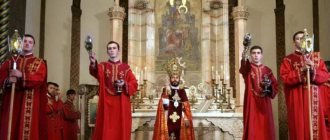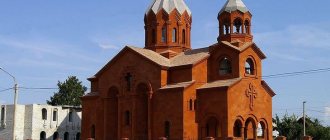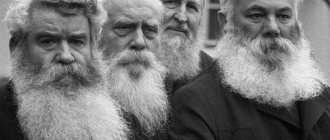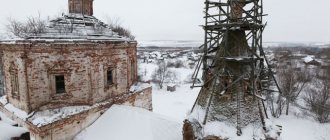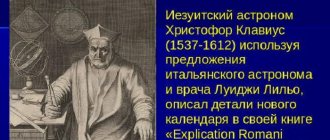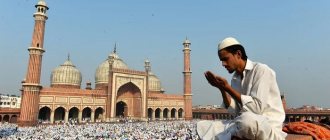The formation of Christianity in Armenia
Before the adoption of Christianity, the people inhabiting the current territory of Armenia adhered to paganism. There is little information left about those times, because the Armenian alphabet was created only in the 5th century. Information was passed on by word of mouth, so many facts about pre-Christian times have come down to us distorted.
The faith of the Armenian people is considered the Chief Apostolic
After the adoption of Christianity, temples were built on the site of pagan temples, so actual evidence of the period of polytheism was also lost. The first people who brought the new faith to the territory of Armenia were the disciples of Christ - the apostles Thaddeus and Bartholomew. Apostle Thaddeus was executed along with his followers.
Similar articles:
- Greek Orthodox Church
- Holy Monasteries of Armenia
Apostle Bartholomew also suffered martyrdom by order of the Armenian king. But persecution could not stop the spread of Christianity. After the asceticism of the apostles, many believers appeared in Armenia. Christians prayed secretly; they did not have churches or other places of worship.
Later, the new religion gained wide popularity in neighboring countries with which Armenia was connected by trade, culture and a common past. This prepared good ground for the spread of Christianity in Armenia.
The situation changed in 314, when King Tiridates III was baptized and issued a decree on the construction of the first Christian temple. This year became the official date of the adoption of Christianity by the people of Armenia.
Interesting to know! The Etchmiadzin Cathedral, founded by Tiridates III, is still considered a religious center for all Armenians. This is the main seat of the Supreme Patriarch and Catholicos.
The break between the Armenian Church and Orthodoxy occurred in the 5th century due to the inaccurate translation of some decisions taken by the Ecumenical Council of Chalcedon.
In subsequent periods, the Armenian Church repeatedly sought common ground with Catholicism. In 1198, a union was signed between the Catholic and Armenian Apostolic Churches, but this led to a schism and the formation of the Armenian Catholic Church. As a result, the Apostolic Church remained a separate independent denomination.
Is there a difference between Orthodoxy and Armenian Christianity?
After Jesus Christ was shamefully executed on the cross and resurrected, his disciples set out on the road to preach the Christian faith.
They told people about the Savior and called them to repentance. As the years passed, the teachings of Jesus Christ gradually spread throughout the earth. Some peoples accepted it with pleasure, while others were very skeptical. For example, another version of the Resurrection was widespread among the Jews.
You can recall the episode from the Gospel, which tells about the soldiers guarding the body of the Savior. When they saw the Angel descending from heaven, they stood up in a daze. As soon as they could move, they ran to the Pharisees and told everything they saw.
And the clergy, in turn, paid the soldiers to remain silent about what really happened. They proposed another version: the disciples of Jesus Christ stole the body in order to deceive the people. And this opinion is still widespread among some people.
Another unpleasant event happened. The division of the church led to the fact that Christianity was also divided into Orthodoxy and Catholicism. But there were other religions that existed in parallel with these two.
For example, the first people to accept faith in Jesus Christ were the Armenians. In the 4th century they became Christians. And they still practice this religion. Is it different from Orthodoxy?
Armenian Church
Many Armenians follow their own ancient Eastern Armenian Apostolic Church. Some historians call it Monophysite. This means that people recognize only the Divine nature in Jesus Christ. Actually this is not true. Modern researchers classify these people as Miaphysites.
In their opinion, in the Savior two natures were harmoniously merged - human and Divine. Orthodox believers are called Dyophysites. They believe that Jesus Christ had two different breeds. One of which was human, and the second personified the divine.
The Armenian Christian Church has another name. Historians call it Gregorian. In the 4th century AD, Saint Grigor Lusavorich participated in the baptism of the Armenian people together with King Trdat. The Armenian Apostolic Church is considered one of the first on the planet.
Its origin is associated with two disciples of Jesus Christ. The Apostles Thaddeus and Bartholomew are the founders of this creed. Armenians do not obey anyone. They are only interested in their religion. And the main city is Etchmiadzin. It is also called the Armenian Vatican.
In addition, in the Armenian religion there is a special cross. He is a symbol of life. This cross stands out for its shape. It has dovetails at the ends.
The crucifixion of Christ is missing on it. Instead, there may be some kind of floral ornament symbolizing life. Services are held in ancient Armenian.
There are differences from Orthodoxy both in the architecture of this religion and in the dating of holidays. Some of them coincide with Catholic ones. Churches have few icons and modest decoration.
Another interesting feature is related to monastic life. Women were not accepted into monasteries, believing that they should be engaged in childbearing.
In modern times, Armenians profess not only their religion. You can meet Catholics, Protestants, and Orthodox Christians in Armenia. And there are even examples of people who converted to Islam.
SOUL PRAYER channel thanks you for subscribing and liking, it really helps you become better!
135
Sacraments of the Armenian Apostolic Church
- Baptism is the very first Sacrament. Without accepting it, a person cannot participate in others. During the Sacrament of Baptism, children are dipped into consecrated water three times, adults have their faces washed or water is poured on their heads. Simultaneously with baptism, the Sacrament of Confirmation and Communion is performed.
In an Armenian church, the altar is not fenced off with icons - In the Armenian Church, confirmation takes place immediately after baptism. It symbolizes the grace of the Holy Spirit and is performed to strengthen one’s faith. The anointing with myrrh is accompanied by appropriate prayers.
- Repentance consists of admitting one's sins. A repentant Christian confesses to the Lord and strives to correct his life. Confession is accompanied by a special prayer and is preceded by several days of fasting.
- When taking communion, believers eat bread and wine as a sign of unity with the Lord and desire for Eternal Life. Before communion, one is required to fast and confess.
- Through ordination and chrism, the priest receives the grace of the Holy Spirit and the right to transmit it to others.
- Marriage is the union of the soul and flesh of husband and wife into a single whole. A loving couple can get married if the boy is 18 years old and the girl is 16. Marriages of convenience and coercion are not recognized by the Church.
- The Sacrament of Anointing is performed in relation to seriously ill patients, in the hope of their recovery or deliverance from severe torment.
Church organization and hierarchy
The highest level of the church hierarchical ladder in Armenia is occupied by the Catholicos. He has the same centralized power as the Pope in Catholicism. In Orthodoxy, Patriarch is an honorary title that does not grant its bearer special powers.
The highest ecclesiastical rank after Catholicos is bishop. Bishops are at the head of dioceses and are required to take monastic vows and have an academic degree.
The main link in church life are priests. They are responsible for the spiritual education of believers, the implementation of the Sacraments and the performance of divine services. Deacons and readers assist the priests.
Differences with Orthodoxy
Despite the fairly warm relations between the Russian Orthodox and Armenian Apostolic Churches, there are many disagreements between them regarding the Eucharist.
Priests cannot conduct joint services, in particular the Liturgy. Believers of one Church cannot receive communion or be baptized in another.
Dogmatic differences
One of the issues that causes the most heated debate among theologians is the question of the divinity of the flesh of Jesus Christ.
The Armenian Church believes that Jesus' flesh was divine. He could not experience human feelings, therefore, his suffering on the cross was symbolic. Orthodoxy adheres to the doctrine of the two natures of Christ. Being God, he took on a human body at birth and experienced all the physical and spiritual torments characteristic of a common man.
Armenian Christians cross themselves with three fingers from left to right
In those days when this topic was raised at the Ecumenical Council, Armenia was in a state of bloody struggle with Persia. The bishops were unable to take part in the discussion and did not accept the decision of the Council, after which a centuries-long division with Orthodoxy began.
Important! Currently, dialogues are ongoing between representatives of the Russian and Armenian Churches about the nature of Christ. If they manage to overcome the differences, full communication between the faiths will be restored.
Ritual features
The Armenian Apostolic and Russian Orthodox Churches have slight differences in rituals, but they cannot be an obstacle to communication between believers.
- At the head of the Armenian Church is the Catholicos, who has comprehensive legislative power;
- The Armenian Church recognizes the decisions of only three Ecumenical Councils out of seven;
- There are few icons in Armenian churches, and at home believers pray in front of the crucifix;
- The Russian Orthodox Church uses the Julian calendar, while the Armenian Church uses the Gregorian calendar. Accordingly, believers celebrate Easter, Christmas and other holidays on different days;
- Believers in Armenia receive communion with unleavened bread and undiluted wine. In Orthodoxy, yeast bread is used, and wine is diluted with water;
- Armenians make the sign of the cross from left to right, while Orthodox Christians make the sign of the cross from right to left;
- According to ancient traditions, Armenians celebrate Christmas and Epiphany on the same day;
- The altar in Armenian churches is not separated by icons; organ music is used during services;
- Widower priests in Armenia are allowed to marry a second time;
- Believers of Armenia can get married on Saturdays and Sundays of Great Lent;
- Armenian believers have a ritual called “matah”. To carry out the ceremony, a Christian sets a table for the poor, without inviting relatives and wealthy people;
- Armenian Christians observe a special fast - Arachavirk. It lasts a week and begins 70 days before Easter.
Important! Despite differences in beliefs, when converting from the Armenian Apostolic Church to Orthodoxy, a person does not need to be baptized again. The rite of accession is performed on a person, during which he renounces the erroneous teachings of the Monophysites. After this, a Christian can participate in the Sacraments of the Orthodox Church.
ARMENIAN APOSTOLIC HOLY CHURCH
Yeznik Petrosyan
Contents Part 1 Part 2 Part 3
PART III
Chapter I The problem of the union of two natures in Christ
The dogmatic theology of the Armenian Church is based on the teachings of the great Church Fathers of the 4th - 5th centuries: St. Athanasius of Alexandria (+370), St. Basil the Great (+379). St. Gregory the Theologian (+390), St. Gregory of Nyssa (+394), St. Cyril of Alexandria (+444) and others, as well as on the dogmas adopted at the Nicene (325), Constantinople (381) and Ephesian (431) Ecumenical Councils. Apart from the Christological question of the union of two - Divine and human - natures in Christ, the rest of the teaching of the Armenian Church fully corresponds to the doctrine of the Orthodox Church. The IV Ecumenical Council, held in 451 in the city of Chalcedon, with its definition of religion, introduced a schism in the Church of Christ, the consequence of which was alienation between the Armenian and Byzantine Churches, between which there had previously been such close ties and mutual cooperation. At the beginning of the 6th century, the Armenian Church officially condemned the creed of the IV Ecumenical Council of Chalcedon. The Orthodox Churches accused the Armenian Church of the heresy of Monophysitism. However, the Armenian Church, like the IV Ecumenical Council, condemned Eutyches, the teacher of the Monophysite heresy, and his defender Dioscorus of Alexandria was not canonized. The New Testament says that the Divine Logos, born of the Blessed Virgin, took on a perfect human essence. According to this, the Church confirmed, refuting the Docetists (a heretical teaching that denies the truth of the incarnation of Christ), the true incarnation of Christ and, refuting the Arians, His Divinity. However, the relationship between the Divine and human essences of Christ was not entirely clear: whether they united into a single whole or remained independent, without affecting each other. The Fathers of the Church called the divine and human principles in Christ nature, or nature. Representatives of the Antiochian school: Diodorus of Tarsus and Theodore of Mopsuestia recognized two different natures in Christ: Divine and human - as opposites that cannot be united or fused into one. Representatives of the Alexandrian school, headed by the Archbishop of Alexandria St. Cyril (+444), based on the teachings of St. Athanasius (+370) and the Cappadocian fathers - St. Basil the Great (+379), Gregory the Theologian (+390) and Gregory of Nyssa (+394) - argued that “two natures are united, but after the union the division into two natures does not take place, therefore we believe that the one nature of the Son” (PG 72, 192-193, Epist. 40). The Third Ecumenical Council, held in Ephesus in 431, condemned the teaching of the follower of the Antiochian school of Nestor, who did not recognize the Most Holy Virgin as the Mother of God and professed the existence of two independent natures, and therefore, two persons in Christ. A few years later, the archimandrite of one of the Constantinople monasteries, Eutyches, preached that “Our Lord consisted of two natures before the union, and after the union he became one nature.” The definition of faith of the Council of Chalcedon says: “Following the holy fathers, we all teach in agreement to confess one and the same Christ, the Son, the Only Begotten Lord in two natures, unfused, unchangeable (against Monophysitism), inseparably, inseparably (against Nestorianism) knowable, so that by union in no way the difference between the two natures is not violated, much less the properties of each nature are preserved and united into one person, into one hypostasis - not into two persons cut or divided, but one and the same Son, the Only Begotten, God the Word, the Lord Jesus Christ.” It seemed that the creed of the Council of Chalcedon had found a solution to the problem: both natures of Christ were confessed, Divine and human, which did not lose their properties in the union - this refuted the heresy of Eutyches. One person, one hypostasis is confessed - this refuted the heresy of Nestorius. However, the Council of Chalcedon could not explain how two perfect natures could be united in one person. The acceptance of the definition of “two natures in one person and in one hypostasis” was hindered by the conviction of that time that two perfections cannot be one and that the presence of two natures presupposes the presence of two persons. Many Eastern bishops suspected that Nestorianism was secretly hidden in the creed of the Council of Chalcedon. The creed of the Council of Chalcedon met with serious resistance in the Eastern Churches: in Cyprus, Palestine, Cappadocia, Syria, Egypt and even in Constantinople. It was rejected by many local Councils. Exploring the Christological thought of the teachers of the Armenian Church of the 5th - 8th centuries, we can dwell on the following statements. Petros Syunetsi (VI century) writes: “In the womb of the Holy Virgin, perfect Divinity and perfect human nature were united in an inseparable and inseparable union.” Catholicos Hovhan Odznetsi (717-728) notes that “we must correctly understand the expression “one nature.” When we say: “The nature of the incarnate Word of God is one,” we must not allow the idea that one has dissolved into the other or that two natures have merged into one. When we say: “One nature,” we mean the indescribable union of the Logos with the body.” In Christ, the perfect Divine and perfect human natures were united inseparably, therefore, by union, “one nature of Christ.” Taking this into account, we can say “one nature” and “two natures”, if they are professed Orthodox. In Christ there are two natures by essence and one nature by union. The teaching of the Armenian Church on this issue was finally formulated by St. Nerses Shnorali in the “Exposition of the Faith of the Armenian Church”, addressed to the Emperor of Byzantium Manuel Komnenos in 1166: “We confess that One of the Three Persons, the Son... was placed in the womb of the Virgin... receiving from Her our sinful and corruptible nature: soul, mind and body ... The Word... did not pass through Her ghostly, as if through some channel, as Eutyches wrongly thought... Not another and another, but One Being and One Person from two natures, in One Jesus Christ united by an unmixed and inseparable union... We confess that from the two natures was made one and that in the union neither of the two was lost.” Speaking about the problem of two wills and two influences, St. Nerses emphasizes: “... We do not understand about will in such a way that the Divine will in Christ was contrary to the human will or the human will of God, but the will of the One Being, who became the Subject, was different at different times - sometimes Divine, when He wanted to demonstrate the Divine power, and sometimes human, when he wanted to show human humility...” “In the likeness of the fact that in the single autocratic will of the Divine there was a twofold desire without resistance (one to the other), Divine and human, we believe that the action in the union was also Divine and human... United of the two opposing ones, having become One, he carried within himself the opposing sensations of both: human nature - suffering and death, and Divine nature - dispassion and immortality. He who died in the flesh lived according to the Divinity.” Russian theologian of the late 19th century. I. Troitsky, analyzing the “Exposition of Faith” by Nerses Shnorali, came to the following conclusions:
1. Nerses Shnorali, according to the Council of Chalcedon, defines the incarnation as the union of two natures: Divine and human. 2. In accordance with the Orthodox Church, it recognizes the body of Jesus Christ as consubstantial with the body of the Virgin Mary, avoiding the error of Eutyches about the heterogeneity of the body of Christ with the human body in general. 3. In accordance with the Orthodox Church, it recognizes that all the essential properties of both natures have been preserved completely in union, and thus rejects the disappearance of human nature in the Divine and the transformation of one nature into another. 4. In accordance with the Orthodox Church, it recognizes the communion of properties. 5. In accordance with the Orthodox Church, he condemns Eutyches and the Monophysites.
Starting from the Middle Ages and until recent years, the Armenian Church called the Orthodox Church Diofzhsite, and the Armenian Orthodox Church - Monophysite. In 1964, in Aargus (Denmark), a dialogue began between theologians of the Orthodox and Ancient Eastern Churches. The parties came to the following conclusions: - The Orthodox Churches are not Dyophysitism, for Dyophysitism is Nestorianism, and the Orthodox Churches reject Nestorianism: - The Ancient Eastern Churches, including the Armenian Church, are not Monophysite, for Monophysitism is a Eutychian heresy, which is anathematized by the Armenian Church . The dialogue continues to this day.
Chapter II Ritual features of the Armenian Church
1. Celebration of the Nativity of Christ and Epiphany on January 6
The Armenian Church celebrates the Feast of the Nativity of Christ on January 6 (January 19 according to the old style) simultaneously with Epiphany under the general name of Epiphany. Other historical Churches celebrate the Nativity of Christ on December 25/January 7, and Epiphany on January 6/19. In the ancient Church, from the end of the 3rd century, the feast of Epiphany was celebrated on January 6. which combined Christmas and Epiphany. In Rome, starting in 336, the Christmas holiday began to be celebrated on December 25. On this day, the pagans celebrated the invincible Sun God (Natalis Solis Invicti), that is, the victory of light over darkness, the predominance of day over night. The Christians of Rome contrasted this pagan holiday with the great holiday of the Nativity of the Sun of Justice, the Nativity of Christ. Soon, throughout the West, Christmas began to be celebrated on December 25th. This innovation gradually spread to the East. So, from 376, Christmas began to be celebrated on December 25 in Antioch (PG 49, 353), from 433 - in Alexandria (PG 77, 1433), from 549 - in Jerusalem (PG 88, 197), etc. . So, all Churches began to celebrate Christmas on December 25, and Epiphany on January 6. Only the Armenian Church has preserved the ancient custom of celebrating the Nativity of Christ and Epiphany on the same day - January 6. The date of the celebration of the Nativity of Christ determines the dates of other holidays associated with the Birth of Christ:
The circumcision of the Lord is on the eighth day after Christmas. 13/26 Jan. (in the Orthodox Church - January 1/14),
Meeting - 40 days after Christmas, February 14/27. (in the Orthodox Church - February 2/15),
Annunciation - 9 months before the Nativity of Christ, April 7/20. (in the Orthodox Church - March 25/April 7).
2. About the sacred bread
The Armenian Church (in agreement with the Roman Church) uses unleavened bread when celebrating the sacrament of the Eucharist (unlike the Orthodox Church, which uses leavened bread). According to the interpretation of the Orthodox Church, the sacred bread should be “two-component, in a mysterious commemoration of the union of two natures in the Lord Jesus Christ (Divine and human).” In the Middle Ages, during Christological disputes, Byzantine theologians similarly explained the use of unleavened bread in the Armenian Church as a custom with dogmatic significance, namely, as recognition of only the Divine nature in Christ, and the non-use of leaven as a denial of the human nature of Christ. However, the Catholic Church, which has the same Christological teaching with the Orthodox Church, uses unleavened bread when celebrating the sacrament of the Eucharist. In reality, the Armenian Church does not attach dogmatic significance to the use of unleavened bread, but only preserves the ancient custom.
3. About the cup of the blood of the Lord
When celebrating the sacrament of the Eucharist in the Armenian Church, whole wine, not diluted with water, is used. This custom is an exclusive feature of the Armenian Church. All other Churches use wine diluted with water. The addition of water to wine was first introduced by Bishop Alexander of Rome (105-115), explaining it as a remembrance of the blood and water that flowed from the Savior’s perforated rib during His suffering on the cross (John 19:34). Gradually this innovation spread to the West and Byzantium. The Armenian Church has preserved the old apostolic custom. According to the teachings of the Armenian Church, the blood flowing from the Savior’s rib symbolizes the sacrament of communion, and the water symbolizes the sacrament of baptism.
4. About the Trisagion Song
The Armenian Church in the Trisagion Song after the words “Holy God. Holy Mighty, Holy Immortal” adds “crucified for us.” Since the Orthodox and Catholic Churches in the Trisagion hymn address the entire Holy Trinity and since the author of adding these words was the Monophysite Peter Knathevs, Patriarch of Antioch (471), then in the Middle Ages the Byzantines and Catholics accused the Armenian Church of adding it expresses the idea of the suffering on the cross of the entire Holy Trinity, that is, it professes the theopaschist heresy. Rejecting this accusation, the fathers of the Armenian Church (Matusaga in the 7th century, Khosrovik in the 8th century, Nerses Shnorali in the 12th century) explained that in the Trisagion Song the Armenian Church addresses only the second Person of the Holy Trinity - the Son, Who was crucified on the cross. “Of course, if we, Armenians, sang this Trisagion hymn to the Trisagion of the Trinity, then it would be an evil and deepest error to add the word “crucified.” But we sing this song to the one Person of the Son and for the sake of the greatest blessings. Those bestowed upon us, we refer to Him the words: God, Mighty, and Immortal, crucified in the flesh for us, have mercy on us.”
5. Sign of the Cross
The Sign of the Cross means the faith of Christians that on the Cross the Savior reconciled people with God, that the power of the devil was crushed by the Cross of Christ, and that through the intercession of Christ we will receive what we ask for. Christians believe that the Sign of the Cross delivers them from devilish forces that are horrified by the Cross of Christ. Armenians sign themselves with the three-fingered Sign of the Cross, folding the first three fingers of their right hand in a pinch, placing the other two fingers on the palm. The right hand with folded fingers is applied first to the forehead, saying: “In the name of the Father,” then slightly below the chest: “And the Son,” then to the left side of the chest, saying: “And the Spirit,” and then to the right side of the chest, with the words : “Saint.” To confirm the truth of all this, putting their palm to their chest, they say: “Amen!”
6. Forward post
The advanced post is unique to the Armenian Church. It comes three weeks before Lent. In the old days, during the Advanced Fast, it was allowed to eat only bread and salt. On these days it was also not allowed to serve St. liturgy. The meaning of the Advanced Post is to cleanse the five human senses from pagan filth. In the ancient Church there was a custom of fasting for five days before baptism. St. Gregory the Illuminator ordered King Trdat and others to fast for five days before baptism in order to get rid of demons. Therefore, the Advanced Post is also called the “post of salvation” (from demonic possession). According to legend. The forward post was established by St. Gregory the Illuminator in memory of the above-mentioned retreat.
There are two explanations for the title of this post. It is called Advanced 1. as the forerunner of Great Lent and 2. as the first Armenian fast.
On the fifth day of Advance Lent (Friday) the day of remembrance of the Prophet Jonah is celebrated, but not as the feast of St. the prophet Jonah, but as a memory of a model of great repentance and abstinence. Sometimes, due to a misunderstanding, the advanced post was called the post of St. Sargis, since on Saturday after Lent the Armenian Church celebrates the feast of St. Sargis. In the Middle Ages, the Byzantine and Georgian Churches blamed the Armenian Church for the Advanced Post, linking it with St. Sargis, who was credited with witchcraft. However, according to the testimony of Armenian medieval writers, the Forward Post existed in ancient times among both the Greeks and the Latins.
7. The attitude of the Armenian Church to holy icons
Since the 10th century, teachers of the Armenian Church have repeatedly accused the Byzantines of excessive icon veneration. They, in turn, accused the Armenians of iconoclasm. The Armenian Church was also accused of this by Syrians, Georgians, Russians and others. To what extent was the Armenian Church iconoclastic? In opposition to the dogmatic decisions of Chalcedon, well-known representatives of Monophysitism: Philoxenus of Mabbug, Severus of Antioch and others, expressed iconoclastic sentiments. But was not the same thing attributed to the Armenian Church by others because it was considered Monophysite? How possible is it that the Christology of the Armenian Church could create iconoclastic sentiments? Study of the Christology of the Armenian Church of the V-VIII centuries. shows that she could not resist the image of the Lord, the Virgin Mary or the saints. Historical and literary evidence and cultural monuments that have reached us prove that in the V-VIII centuries. In the Armenian Church, icons were widely used, frescoes, samples of bas-reliefs and miniatures were created. In the VI-VII centuries. The leaders of the Armenian Church fought against the iconoclastic tendencies of various sects and religious movements. In the IX-XII centuries. in various places of Armenia there were icons of cult significance, such as, for example, the All-Savior Havuts Tara (10th century engraving), images of the Most Holy Theotokos of the Varaga monastery (972) and the nameless monastery of the principality of Philaret Varazhnuni (1071-1166), the church of Surb Khach Zoravorats in Anavarze (1104), Tarson Cathedral (1197) and many others. In those centuries, images of saints were widespread and used in frescoes, sculpture and miniatures. When paintings depicting saints were used, the Armenian Church had a rite of consecration. In the 10th century, along with such a positive attitude towards icons, iconoclastic tendencies also emerged within the Armenian Church. How to explain this? We believe that two main factors played a role in this issue. The first is the rule of the Arabs in Armenia (VIII-IX centuries), who, according to the principles of Islam, prohibit the depiction of people. By order of Caliph Yezid 11 in 716, all paintings depicting saints in Armenia were destroyed and icon painting in Armenia was replaced by painting. The second factor is that in 843, with the victory of Orthodoxy in Byzantium, “icon veneration” became a Byzantine-church feature for Armenian church circles. The dogmatic confrontations that arose between Armenian and Byzantine theologians are also known, and it is natural that in such conditions the Byzantines could blame the Armenians (who, in all likelihood, forgot the veneration of icons under the rule of the Arabs) and, on the other hand, the Armenians, opposing the Byzantines, opposed icons, considering them a feature of the Byzantine Church. This position dominated mainly in Shirak, a region bordering Byzantium, while in the remote regions of Vaspurakan and Syunik, icons were widely used. The above iconoclastic tendency begins to change by the 11th century. Already at the beginning of the 12th century, in the works of Hovhanes Sarkavag, the positive attitude of the Armenian Church towards icons was finally formulated: icons help believers get closer to God. Before the image of Christ one should worship: worship should not be offered to the substance of the image, but to Christ Himself, and before the images of the Mother of God and saints, worship should also be addressed to Christ, since both the Mother of God and the saints can only play the role of intermediaries. You can worship icons only after they have been consecrated.
8. Matah - sacrifice
One of the ritual features of the Armenian Church is matah - sacrifice; its main meaning is donation, bringing a gift to God and showing mercy to the poor. Matah existed back in the time of Gregory the Illuminator of Armenia. After the victory over the Huns, King Trdat with all his entourage, led by Gregory the Illuminator, in the church of St. John the Baptist in Taron made a thanksgiving sacrifice to God, slaughtering many animals and distributing them to the poor. Since ancient times, the Armenian Church has established the custom of making sacrifices on major holidays in connection with the consecration of churches or khachkars. The sacrifice is made for various reasons: - in gratitude to God for deliverance from misfortune or the sending of prosperity - as an intercession for the repose of the souls of the deceased - for the atonement of sins and for the salvation of the soul. A sacrifice requires two ingredients: an animal and salt. The animal must be male. It could be a bull, a ram, a rooster or a pigeon. When a bull is slaughtered, its meat is distributed to 40 houses, the meat of a ram - to 7 houses, and the meat of a rooster - to 3 houses. The meat should not be left over the next day. If a dove is sacrificed, it is released into the sky. Salt must be sanctified - this also distinguishes matah from pagan sacrifice. The meat is boiled in water seasoned with salt and that’s it. As before, so today, many clergy and theologians of the Sisters of the Church blame the Armenian Church for swearing, considering it a remnant of Judaism, paganism and barbarism. However, the custom of the Armenian matakh is a deeply humane, Christian custom, which allows believers to express their love for God, show mercy by helping the poor, etc. The origins of matah come from Abel, Noah, Abraham, Isaac and other forefathers. During the Last Supper, Christ himself ate the meat of the Passover lamb, which is the matah bequeathed by the prophet Moses.
Contents Part 1 Part 2 Part 3
| Additional Information: |
| Source: Armenia.ru Doctor of Theology Bishop Eznik Petrosyan, “Armenian Apostolic Holy Church”, Diocese of the South of Russia of the Armenian Apostolic Church, Krasnodar, 1998. |
| See also: |
| The first bilateral interview between representatives of the Russian Orthodox and Armenian Apostolic Churches The AAC delegation was headed by the chairman of its Department for External Church Relations, Bishop Yeznik Petrosyan |
Dioceses of the Armenian Apostolic Church
The Armenian diaspora in the world is considered numerous. In places of permanent residence, believers strive to found a temple in order to gather there for prayer and during holidays.
Dioceses of the Armenian Apostolic Church are located on all continents, their number in other countries depends on the number of believers. Thus, in Africa the Apostolic Church is represented by only one diocese, but in Europe there are more than 10 of them. In Russia there are the New Nakhichevan and Southern Russia Dioceses.
Armenian Apostolic Church of the Holy Cross Surb Khach in Samara
The most numerous dioceses are:
- Ararat;
- Armavir;
- Georgian;
- Ukrainian;
- Greek;
- Gugarkskaya;
- Swedish.
Guide: Orthodox shrines of Armenia (Part one)
Forefather Noah, apostles Judas Thaddeus, Nathanael and Ananias, Saints James of Nizibia, Euthymius the Great and Mesrop Mashtots, martyrs Gayania and Repsimia, Equal-to-the-Apostles Nina of Georgia, Equal-to-the-Apostles Gregory the Illuminator, Saint John Chrysostom, Prophet John the Baptist. What unites these saints? The fact that their lives were connected in one way or another with Armenia.
Despite the fact that the Armenian Apostolic Church, which occupies a dominant position in Armenia, rejected the decree of the IV and subsequent Ecumenical Councils and has serious differences in its theology from the Orthodox doctrine, this departure from Orthodoxy was not made immediately.
Piece of the relics of St. Peter the Apostle (in the center of the reliquary)
Its exceptional location at the crossroads of trade routes and diverse cultures, as well as almost five centuries of Orthodox history in Eastern Armenia and about nineteen centuries in Western Armenia, has left this country with many great shrines that Orthodox pilgrims aspire to.
Today we will tell you, dear readers, not only about what Orthodox shrines you can see in Armenia, but also how to get to them, where to stay and what “pitfalls” await you along the way.
1. The road to Armenia and inside Armenia
Armenia borders in the northwest with Georgia (and Georgia borders in the north with Russia), in the northeast and slightly in the southwest with Azerbaijan, in the south with Iran and, finally, in the west with Turkey.
After the Armenian genocide at the end of the 19th and beginning of the 20th centuries, relations between Armenia and Turkey were poor. The border is closed. The situation with Azerbaijan due to the conflict around Artsakh (Nagorno-Karabakh) is similar.
Relics of Holy Catholicos Sahak Partev
The country has no access to the sea and can be more or less easily reached through Iran or Georgia. There is a road connection with Iran. With Georgia - road and rail. But this is if you move by dry route.
There are several airports in Armenia, the largest of which are in Yerevan and Gyumri. Armenian Airlines, as well as many airlines in Russia, Europe and other countries fly there. From Russia there are flights from Novosibirsk, Moscow, St. Petersburg, Rostov-on-Don, Sochi, Krasnodar and other cities.
The price of tickets from Russia is on average 35 thousand round trip for one adult. Adults from Russian territory can arrive with internal passports, children with a foreign passport. No visa required. So the fastest and most obvious way to get to Armenia is by air.
The taxi market within Armenia is extremely developed. There is a Yandex taxi service and many private cabs. In the past, Armenia had many factories, many of which were closed during the period of independence and became shopping and entertainment centers, business centers or casinos. Therefore, things are bad with work in the country and many earn extra money in taxis.
Relics of the Holy Prophet, Forerunner and Baptist of the Lord John
Due to strong competition, taxi prices are low; the cars are mostly Western. There are many comfortable Mercedes, Opels, and BMWs. So if you are traveling with a family or a small group, we strongly recommend traveling by taxi both in Yerevan itself and to holy places outside of it. Don't overpay too much.
Of course, you can always get to the right place on a regular bus, but waiting for it, asking for directions and stops, riding in a stuffy cabin is a troublesome and not very pleasant task.
Another option is to come to Republic Square in Yerevan and contact the local organizers of tourist groups. Usually, they fill a minibus with 12-15 people. It turns out even cheaper than a taxi. But there are some disadvantages here. Firstly, you will follow their standard route, which includes not only shrines, but also other local attractions (do you need to go to the pagan temple of the god Mithra in Garni?). Secondly, somewhere you will wait for the group, and somewhere the group will rush you. In general, if you are looking for convenience, we again recommend a taxi.
2. Housing, currency, food and a few other important points
Below are the relics of the Great Martyr George the Victorious, above are the relics of the Holy Apostle Luke
If you are going to Armenia for up to two to three weeks, you can rent a room in one of the local hotels. In a 3-4 star hotel, an unpretentious pilgrim will already be comfortable, but not too expensive. As a rule, most hotels offer breakfast in the booking price, and lunch or dinner in Yerevan can be enjoyed to suit every taste and budget.
But a much better option would be to rent an apartment (apartment) from private owners. A lot of housing is offered in the very center of Yerevan and is quite inexpensive - in the range of 1500-2000 rubles per day. In this case, you will have to cook for yourself, but you will be able to plan your travel schedule much more flexibly.
Armenian hospitality is famous far beyond the country's borders. So most hosts, both in hotels and apartments, will be attentive to your requests and will always try to help. The locals especially love children!
Armenia has its own currency - the Armenian dram (AMD). At the exchange rate, 1 ruble approximately corresponds to 7.2 drams. Prices in Armenia, if converted into rubles, roughly correspond to Russian prices. Some things are cheaper, like a taxi, some are more expensive.
Particle of the relics of the Great Martyr George the Victorious
There are plenty of exchange offices in Yerevan. Starting from the airport and ending with supermarkets. So you don’t have to change a lot of money at once. But on pilgrimage days it is better to have enough local money with you. And among them are several small denomination bills to buy water, food, and souvenirs along the way, since not everyone may have change.
Local guides will disappoint you. They can tell you something about the history of Armenia, a lot about its natural beauty, Soviet past and local legends, and quite a bit about Christian shrines. Even professional guides in the treasury of Etchmiadzin or the National Historical Museum on the topics of Christian shrines, worship and utensils, Orthodox traditions, etc. "float". They will almost always tell you what kind of silver the reliquary of such and such a saint is made of and what kind of embossing is on it, but they will not answer the question of where, when and under what circumstances the relics of this ascetic came to Armenia... Excursions here, unfortunately, are of little use.
If you want to learn more about the shrines, we recommend that before traveling you carefully read the available materials on the Internet or go to the Intercession Orthodox Church in Yerevan (Kanaker district) and talk about them with the clergy.
In terms of food, we can recommend the Petak market. There you will find a lot of good products and quite inexpensively. It is better to buy fruits, nuts and churchkhela on the roadsides on the way to holy places. The prices there are quite cheap, and the fruits naturally melt in your mouth. Especially pears.
Behind the golden cross is the tree of Noah's Ark
If you are free to choose the time for travel, we can recommend September-October. The heat has already subsided, but it is still so warm that you can walk around in a T-shirt or light dress. The fruits are ripe. The days are clear and rain is rare.
3. Shrines of Etchmiadzin
Most of those Christian shrines that are common to the Armenian Apostolic Church and the Orthodox Churches are today concentrated in the treasury of the Catholicos (patriarch) of all Armenians in Etchmiadzin (aka Vagharshapat). This city is home to the theological academy of the Armenian Apostolic Church and the residence of the Catholicos.
The residence has an art gallery and a treasury, access to which is open to everyone - pilgrims and just tourists - for a small fee.
The Holy Spear is one of the instruments of the Passion of Christ
The treasury is open from approximately 10.00 to 17.00 every day except Sunday and Monday. Monday is a day off for almost all Armenian museums.
Here, in Etchmiadzin, there are three ancient Christian churches - the martyrs Gayaniya (Gayane), Repsimi (Repsime) and Shogakat , who lived in the 3rd century. In the temples there are martyrias with the relics of the holy martyrs, which you can venerate.
The treasury of Etchmiadzin contains the Holy Spear , with which the centurion Longinus, according to Tradition, inflicted a wound on the Savior on the Cross. Four artifacts claim to be the true Copy - in the Vatican, Vienna, Krakow and Etchmiadzin. According to scientists, the Etchmiadzin spear is the most ancient.
Another great shrine of Etchmiadzin is part of the petrified tree of Noah’s Ark , which the Monk Jacob, Bishop of Nizibia, found on Mount Ararat in the 4th century. Later, part of the wood of the legendary ship was placed in a precious setting.
Piece of the Life-Giving Cross of the Lord (behind the white stone in the center)
It is interesting that one corner of the square piece of petrified ship wood in the frame is missing. In the 18th century, the Armenian Catholicos (patriarch) Simeon Yerevantsi sent part of the shrine to Russia as a gift to Empress Catherine the Great. This was his gratitude for the Empress’s concern for the Armenian people.
Today, a piece of the wood of the ark of forefather Noah, donated by the Catholicos of Armenia, is kept in Moscow in the St. Daniel Monastery.
The Good News came to Armenia along with the disciples of the Lord Jesus Christ - the holy apostles Judas Thaddeus (Levway) and Nathanael (Bartholomew) , who preached in these places and suffered martyrdom here.
There is no doubt that in ancient times the relics of both apostles remained in Armenia. But constant wars against foreign invaders - Persians, Arabs, Mongols, Turks, etc. did not contribute to the preservation of shrines.
Battle cross of Tsar Ashot the Iron with another piece of the Holy Cross
Today, in Armenia itself, the Apostle Jude Thaddeus has been preserved. They also rest in the treasury of the Catholicos in Etchmiadzin. The ark for storing the relics of the holy apostle is made in the national Armenian tradition - in the form of a blessing right hand. Most of the relics of saints are kept here in similar frames.
In the Etchmiadzin Museum there are also three particles of the greatest Christian shrine - the Holy and Life-Giving Cross of the Lord . One of them was inserted in a special vessel into the marching cross of the Armenian king Ashot the Iron, who raised the shrine over the Armenian troops in battle. The second is in a special gold frame in the exhibition hall. The third is in the storerooms, where many more shrines are stored that are not displayed in the treasury.
Relics of St. James of Nizibia
If we talk about the relics of other early Christian saints, then in the treasury you can see reliquaries with particles of the relics of St. James of Nizibia , Holy Prophet John the Baptist , Holy Catholicos Sahak Partev , under whom St. Mesrop Mashtots created the Armenian alphabet and translated the Holy Scriptures into Armenian.
Also in the exhibition hall of the museum there are relics with the relics of the Great Martyr George the Victorious, the Apostle and Evangelist Luke, and the Apostle Peter .
In the storerooms of the treasury there is another precious right hand with the relics of Saint Gregory, Equal-to-the-Apostles, Illuminator of Armenia . But it is exhibited for worship by believers only on holidays in the Etchmiadzin Cathedral. Also, the reliquary, like the Holy Spear, is used by the Armenian Catholicos in the rite of Chrismation, touching the holy oil with the consecrated oil.
You can read the second part of the guide “Orthodox Shrines of Armenia” .
Andrey Szegeda
Also read: Orthodoxy in Armenia. Modernity.
You can applaud the author (at least 10 times)12
